It may sound odd, but I’ve never met a cow in person before (or bull, or bullock – but I’m gonna call them all cows for the sake of brevity most of the time, sorry).
When I was a teenager in Florida, I had a country-gal friend who had a very tame bull. I did meet him once, with a fence in between us.
Until I moved to Ireland, I never got that close to cows again. They just weren’t common in the places I lived.
So I was thrilled to get an invitation to visit a breeding farm last Friday. I went up after work, in my already-grubby work gear. It wouldn’t matter a bit if I stepped in, or sat in, anything that came out of a cow. After 6:30 at night it was dark and windy and cold and the rain was coming down sideways… but none of that mattered as my friend takes excellent care of his bovine buddies and had them all safe inside the barn, warm(ish), out of the wind and drying off.
First I met the three babies. The white one (male) is about a month old, the two girls are about 7 weeks old.

That’s Bizz, the male. I love his pose in this photo – looks like he is ready for the show circuit!
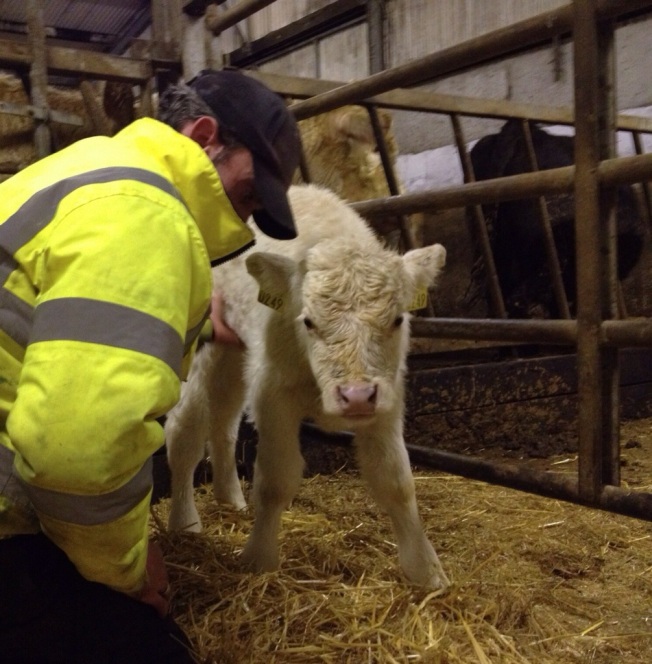
Bizz is my friend’s favourite at the moment, and the one he really wanted me to meet. Little guy had been poorly a few nights previous, and my friend had spent two nights with him under a heat lamp with classical music playing, warm and calm. It worked, as you can see.
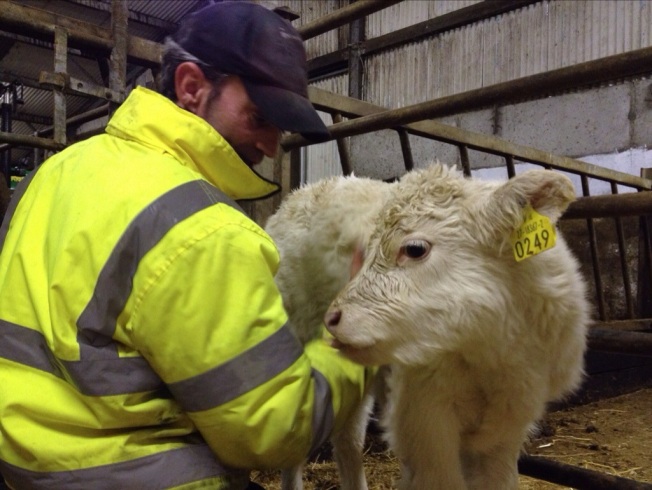
Can you see Bizz’s little tongue? Something I never expected: when you scratch him just right, he starts licking. Rather like when you get the sweet spot on a dog’s belly and the back leg starts to go, or even closer to how some cats get all ‘licky’ when you scratch their back at base of their tail.

Eventually Bizz got past his stranger-danger alert and let me pet him.
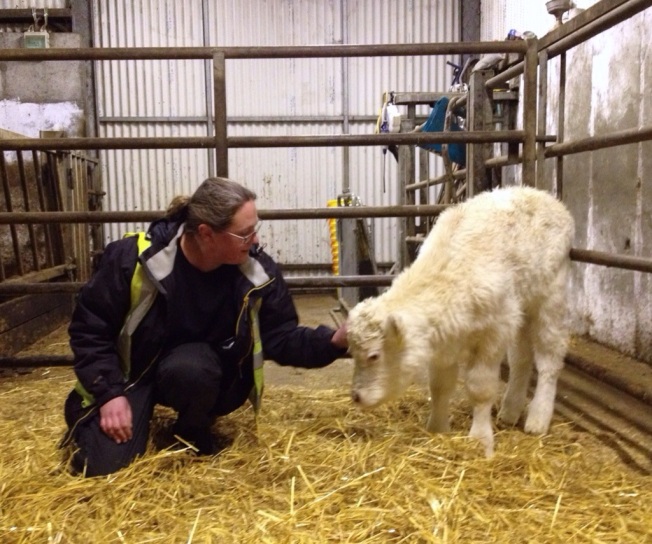
And then the girls, Buzz and Kicker, got a little closer, too.
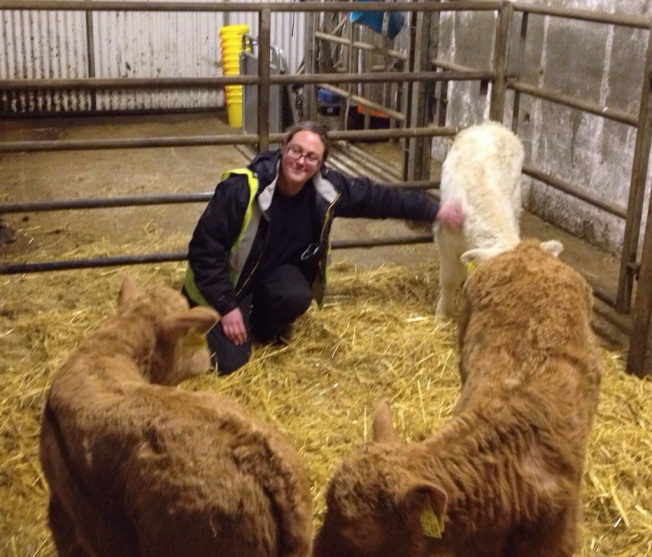
…and they let me be part of their circle for a little while.

Of course we had an audience the entire time. Their mommas were looking through the gates at us, watching over the little ones.
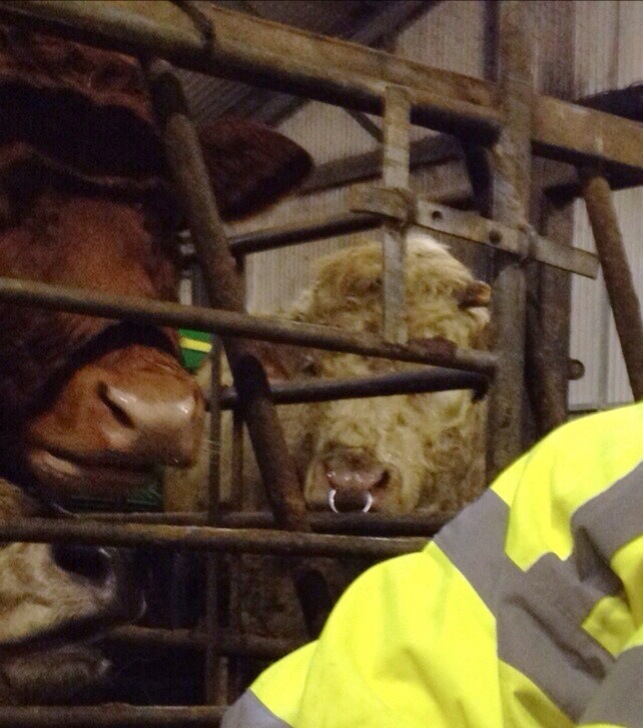
So was the bull, Murty. See him there with the ring in his nose? The big brown gal on the left, Trumpet, was pretty aggressive – I wouldn’t want to meet her without the steel gates in between us! She was the only one in the whole barn that acted as if she wanted to gore me with her (removed at one month or so old) horns. Seriously, she has to be tranq-darted by the vet before he’ll touch her, she’s that bad. She likely won’t be bred again, she’s too dangerous and a bad influence on the babies.

We went around to the other side of the barn where the older calves were sheltering. This photo shows basically what it felt like to be in there with them: a little swarm of nervous 6-month old calves, circling and shifting, head-butting each other out of the way to put a safe distance between themselves and the scary new person. None wanted to get close to me.
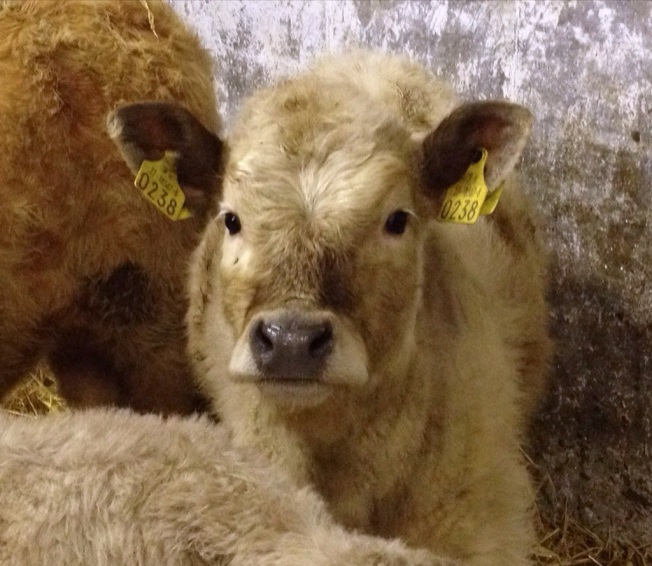
How can you resist this little face? This is the female of the only set of twins born recently. I think she looks like a Siamese cat. Lovely wee thing.

Another one of her, with a little boy in front, who caught my attention later.
We stood in their pen for a while, chatting away about the other cows, and their histories, personalities, and the difficulties and day-to-day of keeping up with a breeding barn.
I have asked to be on-call for the next birth, and how exciting would that be? Who needs sleep when you have a chance to see (and help) a calf being born?
Then I felt warm breath on my ankle, and a tug at my jacket…
I quite quickly had a new favourite: the little white calf, who has a black W on his nose. I’d mostly stopped trying to get pictures by the time I decided I really liked him (I got to scritch his little neck, too), so I don’t have a good photo of him. But maybe that is for the best, as the boy calves go from the breeding farm to the next property, where they will be turned into bullocks and eventually into dinner. It is what it is, and it rather breaks my friend’s heart to send off his favourites. He’s too gentle a soul for this job, sometimes.
These cattle are a cross between charolais and limosin cattle. Maybe a few of my farming friends can enlighten me on the breed characteristics, or how the cross is meant to be? Because except for Trumpet, they were all calm and quiet, even with having the surprise of a stranger in their barn touching their babies. Murty the bull was right there in a pen with a few of the girls, not a bother to anyone, and barely glanced at me. Of course I will put a lot of their temperament down to their caretaker, who never hits or prods them, and spends all of his day (and sometimes all of his night) with them.


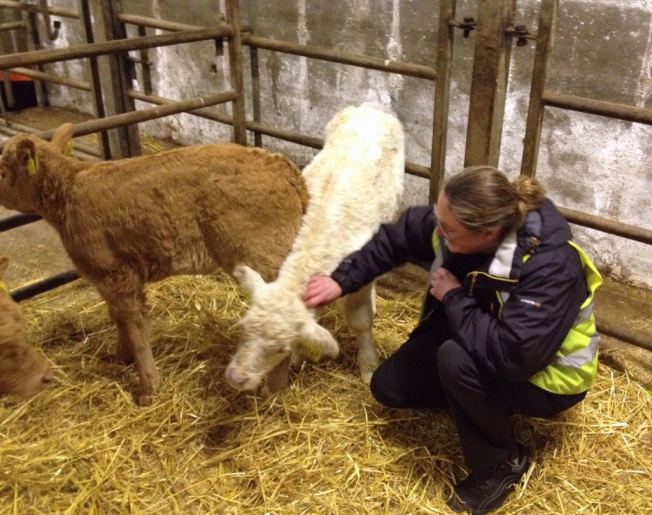
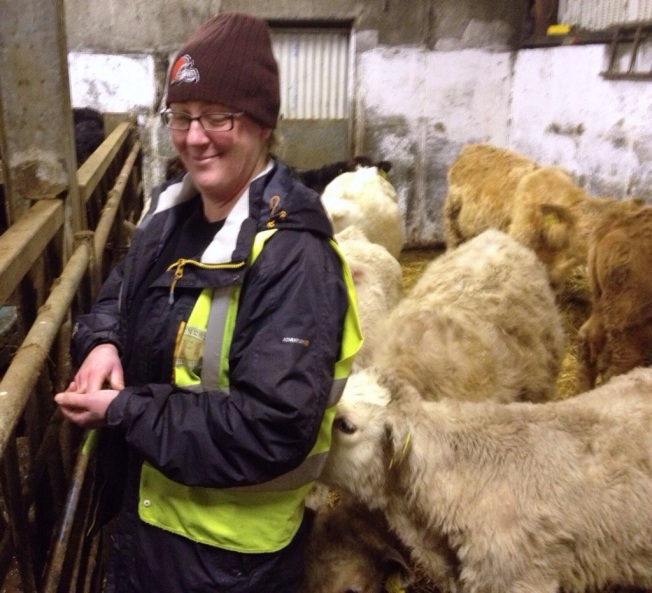
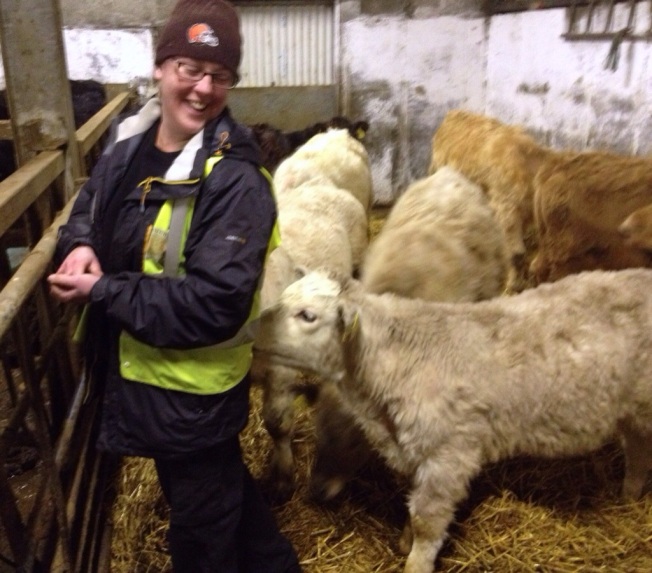
Lol looks like you had great fun. Calfs are sweet but I prefer the wee lambs 🙂
I’ve not gotten to meet any of them, either!
Oh you have to meet them. I delivered one once then put it in the oven…to warm it up that is lol
Yeah… I’ve had the ‘other reason’ for putting them in a oven, and I actually don’t care for the taste. I apologised for weeks to every lamb I saw in a field.
Aww I can understand that lol When I was young, lambs in boxes in my Uncles Aga was a regular thing, bottle feeding them was hilarious lol
Next time you get to spend time with young calves, please do try sticking your hand, palm upwards into their mouths. They suckle you and the sensation is just gorgeous. Soft and warm and lovely! The photos are great and you ‘got’ them.
It’s lovely when they suck your fingers..so strong!! 🙂
I didn’t think to try that, they were so shy!
🙂 bless em 🙂
Have you ever felt a cow tongue? You’ll never forget it if you do. Like sandpaper.
No, but they don’t look too nice when wrapped in plastic in the supermarket! What did B think about the cows?
Industrial sandpaper at that 🙂
Squeeeee love me baby moo cows..i could spend my life watching cows graze in paddocks..it’s the most serene sight..and yes our sheep nibble denim and jackets…all potential food! what beautiful pictures 🙂 with the sheep if we rub their heads they want to butt you and start a wrestle so it’s behind the ears..and like dogs they lean on you when getting scratched 🙂 your friend is the reason they are so calm..all cattle can be rowdy even when hand reared..the same with sheep..we have had our boys as lambs and even so ..when Oscars ‘bits’ dropped (his ring didn’t work and voila we had a ram!) he would hunt me down for some fun..we had to take him to the vets in the car to get them off!! he would head down stomp the ground and go for me..since I had a knee op recently couldn’t have him doing that..plus a full ram can do a lot of damage to you! he is fine now ..great pics and hope you get to witness a birth..be prepared sometimes things go wrong and it can be very distressing..hugs Fozziemum xx
I know a little bit about a lot of things, but I still want more! What is the ring of which you speak? I’ve seen a horse castrated, and saw the antique bullock-maker my friend still has. But a ring is a new one on me! I’m sure we are all (mostly) adults around here and can take the details – with a few private giggles if needed!
My friend got surprise-cow kicked by one of the 6 month olds, I wouldn’t like that much at all. I expect a whole sheep hurtling at me bony head first would be a very bad thing!
I learned about the calving jack on my visit, too (no pics so I didn’t mention it in the post). Seems like an incredible amount of hard work for the human helper. I’m pretty tough about these things – might cry a bit but it won’t break my heart like running over that kitty did…
The ring is put around the young males danglers..yep I am a grownup and said danglers bwahahaha and works by cutting off supply and then their danglers dangle no more..what must have happened with Oscar is when the owners grabbed his danglers his testicles must have hidden up in his guts…smart Lamb! so what dropped off was an empty sack…looked the same as Jock and Felix’s and surely just the same fun for the dogs who found them…ewwww…anywho when they had their first shearing…there they were…no longer hidden..and once they were shorn he got all testosterone man…not pleasant being chased by a ram with and erection ….ever….;) my sister got knocked out feeding a potty calf..she was bent over with the bottel and he banged his little head up like he would to mums udder to let the milkdown..out cold…ironically this sister is a cow and I say well played 😉
Yowch. Yeah our barn dog and cats had to be kept off the horse’s oysters, too. Though really should have let them have at it, good for em!
Hahah oh dear you are terrible about your sister! By the way I love how we can chat before I go to bed, and again when I’m up in the morning! Usually everyone in the US is still asleep this time of day for me.
Hahaahaha yep off to bed now though..been side tracked…..and yes I am horrible ..but she is a right piece of works 😉 long story….which I think you would love bwahaahaah 🙂 nitey nite Fozziemum xx
Or is it nearly good morning, now that I’m home from work?!? Haha! Too funny. I’d love to sit with you and have a long chat, I’d bet we’d laugh for hours 🙂
For me it’s now night…and I agree think we would pee our pants 😉 bwahahahaah
Hum! I really was too absorbed by your story, I read this as this:
not pleasant being chased by a ram with and erection ….ever….;) my sister got knocked *up*
Bwahahahahah..she may have..her kids are just as odd as her …just sayin;)
Very sweet…. he was trying to get ahold of something to suck with that little tongue of his. We never put them into a barn here… they would all get pneumonia… difference in climate i suspect. we’ve had both these breeds briefly but just have black angus now… a pain in the butt but seems to be what sells the best off grass. 😉
Very different climate! It’s nearly always wet here. The pens for the adult cattle are a slatted floor with a huge poop tank underneath, only the little ones get the bedding. Fresh grass outside, and during the summer the grass is cut and baled for the winter. The black angus craze hasn’t really hit over here like in the US, it seems. Maybe in Scotland it has!
Have a good day/night! xox
These are dear creatures, but what are they being bred for….?
The boys are to become meat, sorry. The girls only if they aren’t good breeders. You know I’m an omnivore, so I have to say I think they have a good life, up until they don’t anymore, of course. I’ve not seen THAT yet, either, but iDJ has.
These cattle do look like they are being well treated and not just turned into machines for producing meat; which unfortunately is how it is across most of the US.
You only have to go one generation back in my family to find working farmers — long dead now, but I saw what a farm was like 50 years ago. I don’t think there’s much of that left here now, American meat doesn’t come from places you’d want to visit.
If you buy Irish meat or eggs (or veggies) the package has the name and location of the farm it came from. You can visit any of them if so inclined. It’s one thing I can find no fault with here.
Ah! That’s so nice! Best way to decide where to buy your food from!
Here they have associations. Pork is labeled by the pork association, beef by the beef association, etc. You cannot know where it’s really from. The idea is to ensure that all farmers have the same chance at selling their stuff equally. They even have quotas so that smaller producers can make a living among the larger producers. The downside is this though, they don’t have to improve their quality, or how they care for the animals.
We are a hell of a lot smaller over here 🙂
Same goes here. I can tell not much of these farmers really care for the cattle. I once encountered one that raised lambs and he seemed to enjoy his job, and cared for the animals properly and the lambs would actually come and see the visitors.
As a kid, I grew up on farms. My parents had mostly rabbits (a few chicken for eggs but that’s about it), but most other farms had cattle for milk (we don’t produce much meat here, they do that in Alsama). I can tell these cows feared humans for the most part. As kids, we would often walk through the fields, to avoid the long walk around, and the cows would just run away. The culture there was that these were a resource (food), and they were not to be played with or around. I sure didn’t know they had a hot spot. My parents scolded us when we played with the young rabbits like they were cats. I wasn’t born on these farms, I didn’t have that culture, they were fun to play with. I only knew much later that I wasn’t eating pork that often.
Never eaten rabbit. Thought it was meant to be like chicken 🙂
The cows here were timid as well – but not from abuse. They are a prey animal and they know it, so be wary of strangers and seek safety in the herd.
I want a baby cow!
I wouldn’t want one in the living room! I might not have carpet now, but still… they are worse than birds for just ‘letting rip’ with what ever they don’t need anymore!
What a fun experience for you! It looks and sounds like you had a terrific time. This post makes me miss home. I grew up on a ranch and those years were by far the best years of my life. Our cows were all very sweet too. I had a pet cow named “Moo Moo Cow”. That name’s pretty original isn’t it? Ha!
Aww, that’s cute though!
I love cattle! And as you see they are not dumb or stupid or any of those things people say…they are just as sweet and kind as other house pets…only lots bigger.
Linda
http://coloradofarmlife.wordpress.com
*♥´¨) ¸.-´¸.-♥´¨) Happy Valentine’s Day¸.-♥¨) (¸.-` ♥♥´¨
Not a bit dumb! As smart as they need to be to keep being cows 🙂
What a great adventure – barns are so lovely. The “siamese cat colored” one is a wonderful shot – such expression. They are such sweet babies – but best not let them into the house even if sick – they get very big, but still think they are calf size. My sister in law bottle raise one of hers after the mom died, and after it was sent outdoors, the darn thing would barrel right through the screen door…and looked like such a happy puppy.
Sounds like cow heaven on that farm – nice to hear that.
Oh my! Yes, I don’t think I’d like that much!
It got to be a problem — he just didn’t understand why he couldn’t go in the kitchen any more…and they have those big eyes
I said most of what I wanted to say as an answer to Sledpress above…
I can’t identify any cow breed, except for the famous Holstein. We don’t have much Holstein here though. We have just brown cows. I have no idea what their name really is, we just called them brown cows. We had Holsteins and brown cows. As I said, we don’t produce much meat, almost only milk, brown cows are for milk, they don’t produce much fat. I can tell these cows on the pictures are of a different breed than our brown cows. They have much longer hair and their tail is much larger than our cows. That’s what I noticed the most.
He told you what the nose ring was for, didn’t he? Oh he didn’t? Well, what I’m going to tell you is what I have been taught by these farmers as a kid. You’d be a nice girl to ask and check if I was taught right. They put the ring in the nose of those more aggressive beasts, mostly males (males are usually more aggressive than females — they are not fixed because they really only serve reproduction, since their meat is not good enough). The ring is so that you can pick the ring when the animal get too aggressive. I was told that when you hold that ring, the animal will act like a gentle kitty. He will do anything you want him to do. But I never got to try (or see anyone do it) as they really said to not approach those with a ring, they were the dangerous ones. Now I can tell those with a ring ran away just like the others when we walked in their fields.
Cows have been domesticated for thousands of years. They are not what they used to be in nature. Any intelligent farmer would only breed those that aren’t aggressive, because the aggressive ones are just trouble makers. Making their days difficult. That’s how we end up with cows which are not very aggressive. We have a joke here that a bunch of hungry ants could put down a cow in a few hours, because the cows have been domesticated for so long that they can’t defend themselves.
Yep, our dairy cattle are Holsteins also. I already knew about the ring in the nose, so I had no reason to ask 🙂
I’m not sure what happens to male Holstein calves. Maybe pet food if they don’t taste nice. They cut the nuts off of the male beef-cattle and let them get about a year or so, full grown, then off to the butcher. No need for ring on those guys, they are very gentle.
Also all of them get their horns removed very young. At this farm, it is done under a local anaesthetic. Some places wait until the animal is large and saw the horn off, no painkiller. Not nice.
Neat!
Glad to be able to do this, for sure!
Thanks for sharing the link to this on my blog. What a grand experience! Where I live in New England in the US there are lots of small farms and folks who raise their own animals. I have chickens, myself. To my way of thinking, if one is going to eat meat, one needs to be responsible for it. Don’t live in denial, buying it in anonymous packages from the store as if it were painlessly manufactured. Understand where it comes from, and feel gratitude and compassion towards the creature which is supplying it. Make certain their brief lives are happy.
Wonderful photographs. Clearly these are animals that are loved and well-cared-for. Wish this was the norm.